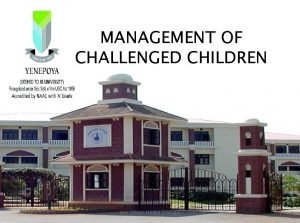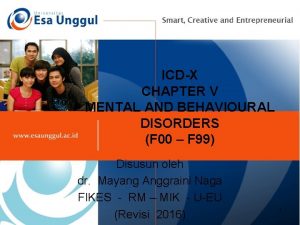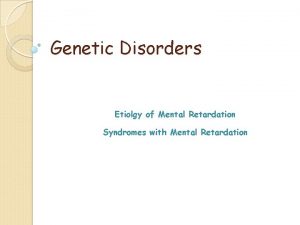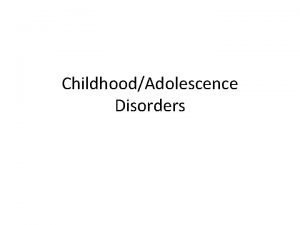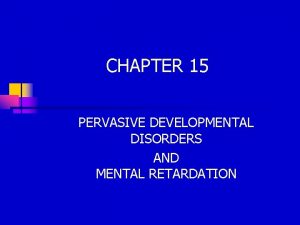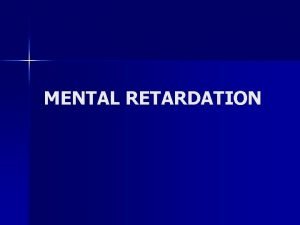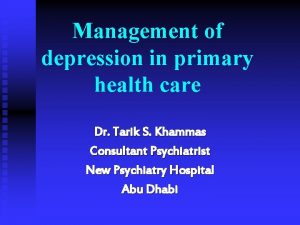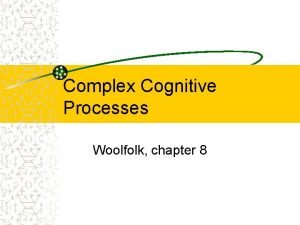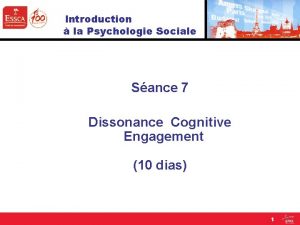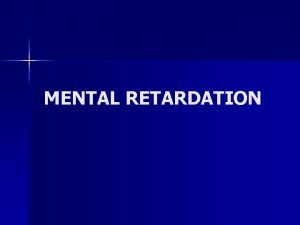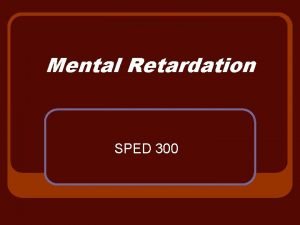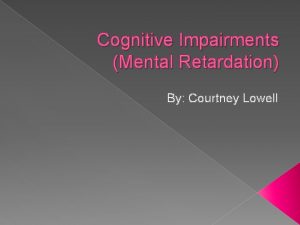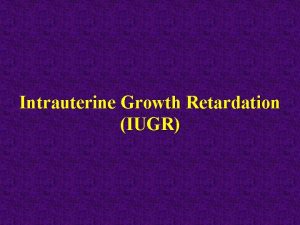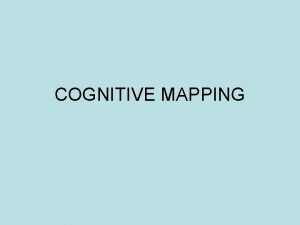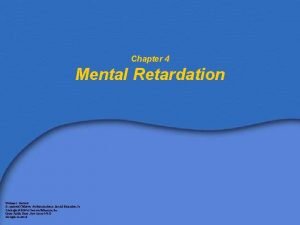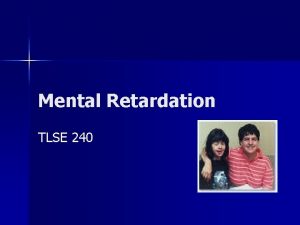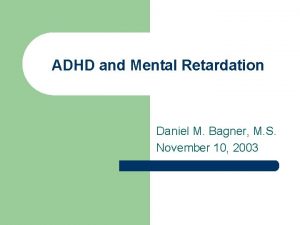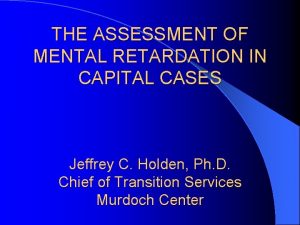Mental Retardation Definition Mental Retardation is cognitive performance























- Slides: 23

Mental Retardation

Definition Mental Retardation is cognitive performance that is two standard deviation below the mean of the general population (below the 3 rd percentile ) l Deficits in IQ and adaptive functioning l IQ of 70 or below

Degrees of Impairment (DSMIV) diagnostic &statical manual of mental disorder l Mild MR (IQ of 55 to 70) – applies to about 85% of persons with MR – typically not identified until elementary school years l Moderate MR (IQ of 40 to 54) – applies to about 10% of persons with MR – usually identified during preschool years – applies to many people with Down syndrome

Degrees of Impairment (cont. ) l Severe MR (IQ of 20 to 39) – applies to about 3%-4% of persons with MR – often associated with organic causes – usually identified at a very young age l Profound MR (IQ below 20 or 25) – applies to about 1%-2% of persons with MR – usually identified in infancy – almost always associated with organic causes and often co-occurs with severe medical conditions

Causes of Mental Retardation Genetics: – chromosomal abnormalities are the most common cause – – – of severe MR Down syndrome due to an additional 21 st chromosome Prader-Willi and Angelman syndromes both associated with abnormality of chromosome 15 Non chromosomal abnormalities: AR, PKU AD , Neurocutanous disoders like Neurofibromotosis, TS. Fragile X syndrome.

Causes of Mental Retardation Environmental l Neurobiological influences – adverse biological conditions (e. g. , malnutrition, exposure to toxins, prenatal and perinatal stressors) – infections, traumas, and accidental poisonings during infancy and childhood – prenatal alcohol exposure can lead to a Fetal Alcohol Spectrum Disorder (FASD) l Social and Psychological influences – deprivation of physical and emotional care and social stimulation particularly influential

Down’s Syndrome Most common chromosomal abnormality leading to MR (1. 2/1000 births) l Nondysjunction of chromosome 21 l Relative strengths: l – Visual (vs. auditory processing) – Social functioning l Relative weaknesses: – Language expression and pronunciation Generally viewed to suffer less severe psychopathology than other developmentally delayed groups l After 40 years of age, affected individuals nearly always demonstrate postmortem neuronal defects indistinguishable from Alzheimer’s Disease l

Down’s Syndrome

Fragile X Syndrome l l l FMR-1 gene (>200 trinucleotide CGG repeats, Xq 27. 3) An example of a “dynamic mutation” where more mutations occur with successive generations General problems: MR, mild CT dysplasia, & macro-orchidism Only 50% of females with the full mutation demonstrate IQs in the borderline/mild MR range (vs. 100% of males) Increases the risk for ADHD, autism (20 -60%) & social phobia Increasing deficits in adaptive and cognitive functioning with age

CF l Long face & large floppy ears. l Macrocephaly & Macro-orchidism. l Epilepsy & MR ( moderate , severe) l CT dysplasia ( extensible finger JJ, MVP) l Autism l DX: Cytogenetic analysis. (for repeats)

Fragile X Syndrome

Fragile X Syndrome

Phenylketonuria Genotype: • AR disease due to Mutation of the enzyme, phenylalanine hydroxylase (PAH) that hydroxylate phenylalanine to Tyrosine. Phenotype: • Mental Retardation, Seizures, Fair Skin, “Mousy Odor” & Eczema.

The normal metabolism of phenylalanine (pathways a and b) BREAKDOWN Dietry sources, particularly plant proteins PHENYLALANINE HYDROXYLASE (a) TYROSINE (b) BODY PROTEINS © 2008 Paul Billiet ODWS

The abnormal metabolism in phenylketonuric subjects (pathway c) HYDROXYPHENYLACETIC ACID* ACID Dietry sources, particularly plant proteins (c) PHENYLALANINE* PHENYLALANINE HYDROXYLASE (a) (c) (b) PHENYLACETIC ACID (Brain)* BODY PROTEINS *Agents, thought to be responsible for mental retardation © 2008 Paul Billiet ODWS

Symptoms of PKU l Normal at birth l At 2 month (Vomiting, lethargy) l Light hair, eyes, and skin l Eczema-like rash l Seizures (Hypsarrythmia) l Hyperactivity l Hypertonia and hyper-reflexia. l Unpleasant musty/ mousy body odor l Mental retardation & microcephaly.

PKU Neonatal screening & Dx – Guthrie test 1961 : Blood spot Horst Bickel and Robert Guthrie (filter paper) samples using the Guthrie bacterial inhibition assay – Urine ferric chloride test (Ferric chloride + urine of new born baby Green colour in the presence of ketone bodies)

Treatment l. A strictly controlled phenylalanine free diet (phenylalanine free formula) l up to the age of about 14 years old l After this age the growth and development of the brain is not affected by high levels of phenylalanine in the body © 2008 Paul Billiet ODWS

History » complete and detailed history « complete systemic review pregnancy history : maternal age , parity , infections. . birth : type , wt. GA , complications , apgar score Postnatal : incubator , ventilator , disease. .

History (cont. ) developmental Hx : mile stones , speech. . educational Hx : schooling , IQ tests behavioral Hx : skills , attention , activity family Hx : consanguinity , inherited ds. .

Examination • • • » complete and detailed examination « Growth parameters : Dysmorphic features : CNS examination : Other system and skin exam : IQ tests : Developmental testing :

Investigations » » there is no specific investigation for MR but good hx and physical examination guide us toward the proper one « « q DNA analysis: chromosomes q FISH probes: Prader-willi, wiliams, cri du chat syndrom (Fluorescence in situ hybridization (FISH) is a molecular diagnostic technique utilizing labeled DNA probes to detect or confirm gene or chromosome abnormalities. ) Metabolic labs: plasma a. a. , urine organic a. , TFT , ck q Imaging : brain MRI , CT , skeleton films q Psychological Assesment: q Electrophysiology : EEG , auditory & visual evoked potentials q

Management of MR » » there is no specific Rx for MR « « » General rules : -Identify the cause then initiate a comprehensive plan -Special educator , Language , behavioral and occupational therapists -Special school programs -Community services
 Nursing diagnosis on mental retardation
Nursing diagnosis on mental retardation Management of challenged children
Management of challenged children Mental retardation levels
Mental retardation levels Icd 10 mental retardation
Icd 10 mental retardation Levels of mental retardation
Levels of mental retardation Mental retardation classification
Mental retardation classification Nursing diagnosis mental retardation
Nursing diagnosis mental retardation Levels of mental retardation
Levels of mental retardation Mental retardation ppt
Mental retardation ppt What are the classification of mental retardation
What are the classification of mental retardation Cognitive and non cognitive religious language
Cognitive and non cognitive religious language Birefringence retardation
Birefringence retardation Interference figure
Interference figure Psychomotor retardation
Psychomotor retardation Chapter 20 mental health and mental illness
Chapter 20 mental health and mental illness Mental health jeopardy questions and answers
Mental health jeopardy questions and answers Bars performance appraisal
Bars performance appraisal Performance management vs performance appraisal
Performance management vs performance appraisal Jcids process
Jcids process What is cognitive flexibility
What is cognitive flexibility Ap psychology chapter 8 emotion and motivation test
Ap psychology chapter 8 emotion and motivation test Complex cognitive processes
Complex cognitive processes Cognitive economy psychology definition
Cognitive economy psychology definition La dissonance cognitive définition
La dissonance cognitive définition

